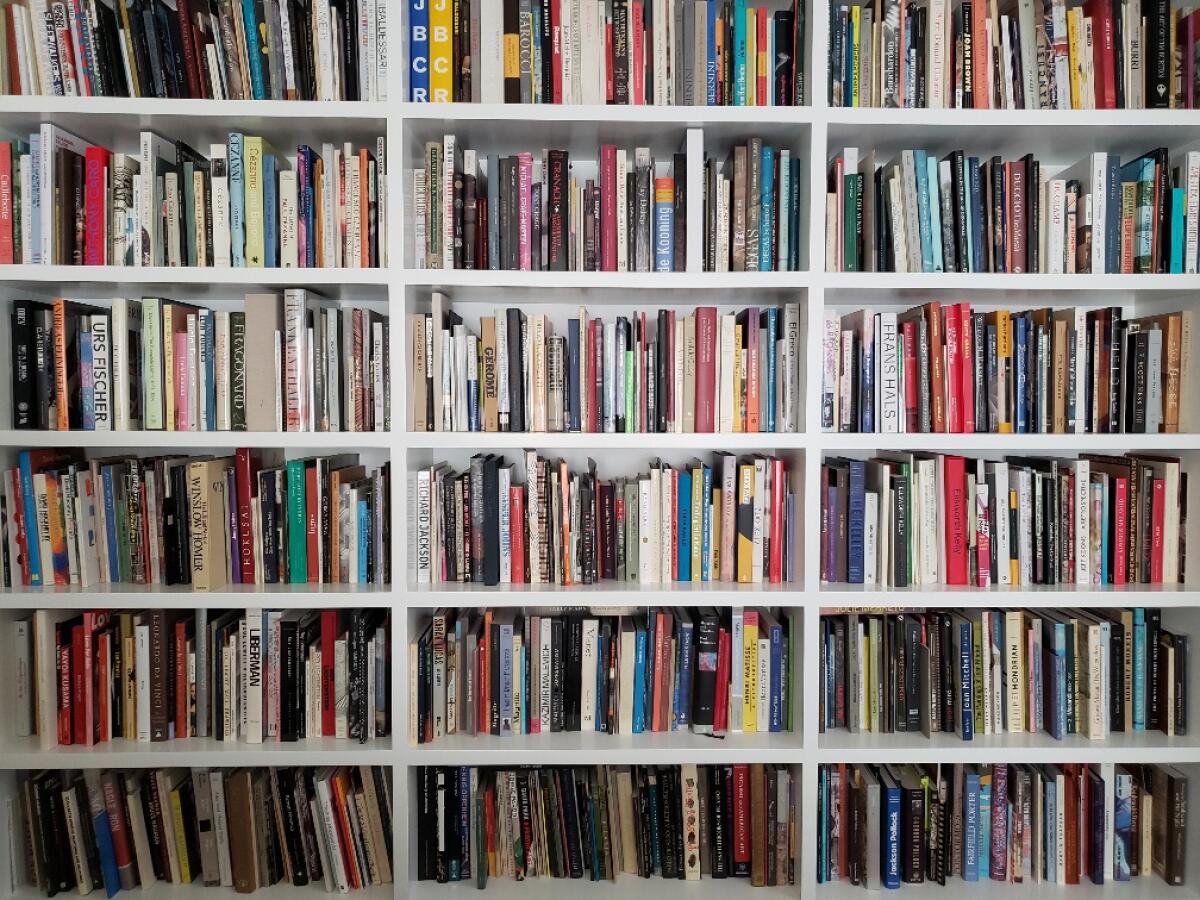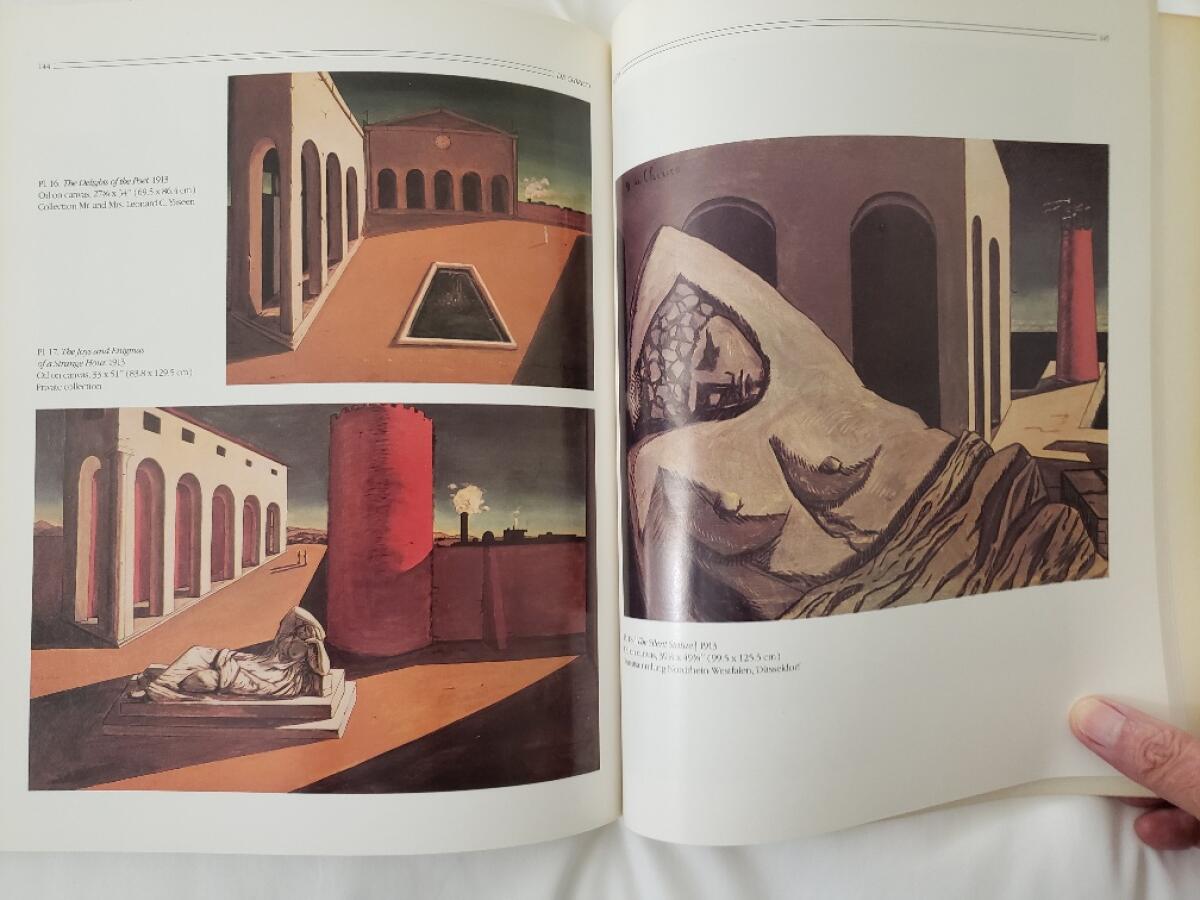Finally, the time to organize my library. All 2,000-plus books

Do you file De Chirico under D or C? Times art critic Christopher Knight works out answers — and finds the process can bring a flood of memories.
In my home library, “De Chirico,” the slim but invaluable catalog to the Museum of Modern Art’s marvelous 1982 survey of the perplexing Italian metaphysical painter Giorgio de Chirico (1888-1978), had been shelved upside down.
I wasn’t surprised. My art-book library is not disorganized, but neither is it as shipshape as it should be.
When I pulled the catalog down the other day to turn it right side up, I wondered for a moment: Should I leave the book filed here, right between Spain’s Eduardo Chillida and Bulgarian American Christo, with the artists whose names begin with C? The single-artist monographs that make up the lion’s share of my library, whether catalogs, biographies or art history books, are lined up in basic alphabetical order.
Or, should De Chirico be shelved under D, the way the four books on Jay DeFeo and the five on Willem De Kooning are?
Ready to watch that Pulitzer-winning play you meant to catch years ago? Want to time-travel to see Angela Lansbury do “Sweeney Todd” in 1982? Here’s how.
Nobody refers to those two artists as just Feo or Kooning, I reasoned, but often the Italian artist is just called Chirico. So, I decided to leave the catalog shelved under C.
Multiply that pause a couple hundred times over, however, and the reason becomes clear why I had procrastinated on the task of straightening up my art library — which numbers more than 2,000 books. More than two years ago I moved, and during all the packing and unpacking the filing system had occasionally gotten jumbled.
Now, with the novel coronavirus pandemic shutting down art museums and galleries all over Southern California, I had an opening. With cautions for social distancing keeping me at home more than usual, fixing the shelving glitches seemed a productive way to spend the time.
I did not expect that it would be fun. Turned out stumbling on favored if forgotten art books has its rewards.
Of all the onerous aspects of closing out one house and moving to another, none had been less pleasant than moving my library. The professional movers could pretty much disassemble the kitchen and cart out the furniture on their own. But the books? Not the books.
That required unusual prep. Alphabetical order had to be maintained — by artist for the monographs and by author for the books of criticism. Histories are grouped by geography and period, depending on the book’s subject, and on occasion by art medium. Some catalogs were kept together by museum or location — especially group shows, like Hammer, Whitney and Venice biennials.
Coronavirus canceled individual productions or entire seasons (not to mention all of Broadway). Here’s how some are reopening on a digital stage.
In the process of packing, I set a couple hundred books aside, thinning the herd. Those I gave away.
Labeled and numbered moving boxes were prepared — a lot of them — but there was no way to keep the order of books exact inside each box. Some books fit, some didn’t, and the movers had a job to get done.
At the other end of the move, labeled boxes were divided up among the three different rooms where shelves had been built — “A” through the start of “R” in one, the rest of “R” through “Z” in another, all the remainder in a third. A helpful friend unpacked and placed books in whatever order they came out of the boxes.
Most of it worked pretty well, but a chunk of it did not. I put off the fixes for months.
OK, for years.
What surprised me when I started going through the shelves the other day was that it turned out to be not the least bit unpleasant. I had really admired that MoMA De Chirico show, for instance, but I hadn’t cracked that catalog in decades. Doing it now brought me back.
I went into a file cabinet to dig out what I had written about De Chirico’s anxiety-ridden visions of vacant Italian cityscapes populated by ancient sculptures and distant railroad trains, all of it slashed by raking shadows. Most of the review seemed just fine. Then, flipping through the book, my eye snagged on a couple of picture-pages.

Plazas are nearly empty, long corridors of Roman arches are blank, sharp perspective lines don’t quite match up, which sends the ground plane tilting up and down. Steep shadows cast by a late afternoon sun, forbidding fortress towers, the Vatican’s famously uncomfortable sculpture of sleeping Ariadne from ancient Greek myth — the images were familiar. The years leading up to the nightmarish catastrophe of World War I are hauntingly evoked.
Yet now the paintings look a bit different. The current social climate has added another layer.
Today the subtle perspective dissonance in De Chirico’s rendering of civilized places still quietly destabilizes. Although a century old, Italy’s haunted scenography can’t help but suggest the latest news, littered as it is with lockdown pictures of an unpopulated St. Mark’s Square in Venice, a tourist-free Colosseum in Rome, Milan’s elaborate Duomo on a Sunday morning without services underway.
History has a way of intruding on the present. And yet, while the sinister aura of those paintings is familiar, solace also lurks. De Chirico took a long view, from the ancients to modernity. World War I opened a wound that would be decades in healing — but here we are.
‘Sweet Land’ by Yuval Sharon’s the Industry, was being performed at Los Angeles State Historic Park until it was cut short due to the coronavirus.
Rummaging through bookshelves is a different experience from searching online. Both court serendipity. But the accident of a book, perhaps because it is a physical object rather than the glowing ephemera of digital pixels, is of another order. It has a singular density and weight.
Unexpectedly, stumbling on the reproduction of De Chirico’s 1913 “The Joys and Enigmas of a Strange Hour” also propelled me back to childhood. I grew up in a small New England town, where the presence of art barely registered beyond the bronze sculpture of Revolutionary War Gen. William Shepard guarding the village square. It was designed by Henry Augustus Lukeman, a notable student of Daniel Chester French, sculptor of the brilliant Lincoln Memorial.
In the public library adjacent, where my dad was a volunteer on the board of directors, I spent lots of after-school hours in junior high churning out homework. Finding myself one day in the fine arts aisle for no particular reason, I pulled out a book and discovered something that appeared inexplicable.
Some guy named Hans Hofmann had made paintings of bright rectangles and smears of color on canvas. Thinking back, was this the 1961 book by Clement Greenberg, or maybe William Seitz’s 1963 MoMA catalog? I have no idea, but I vividly remember my first encounter with abstract art, once-removed through reproductions. I figured the inexplicable paintings must be important, because here they were reproduced in a library book in a Podunk town.
I remember because I returned to that book on many subsequent afternoons, trying to make heads or tails of those paint smears and colored rectangles. Recalling the experience now, I went to the H shelf of my own art library to see what I could find — but to no avail. It seems I don’t have a Hofmann book.
At least, I don’t have one that has been properly shelved. Maybe it’s somewhere else. When I get done with my project, currently at C, I will know. Just a couple thousand books to go.
More to Read
The biggest entertainment stories
Get our big stories about Hollywood, film, television, music, arts, culture and more right in your inbox as soon as they publish.
You may occasionally receive promotional content from the Los Angeles Times.












